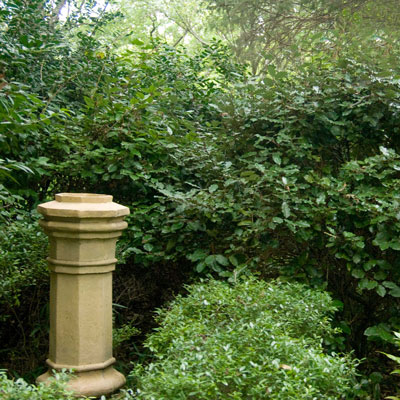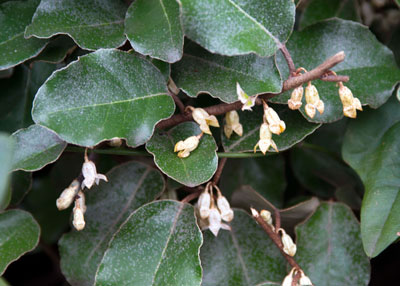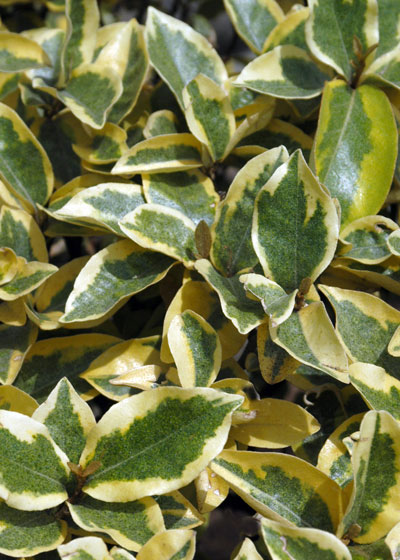Elaeagnus: Durable and Fragrant
I grew up with this plant all around me there on James Parkway in College Station. Every fall it filled the air with its wonderful perfume. Encountering it now is like a trip back to my childhood. Plus, it’s one of our best landscaping shrubs to boot.
Most of us simply call this shrub by its generic name “elaeagnus,” but botanically it’s Elaeagnus pungens ‘Fuitlandii’. If you look in gardening references, you’ll find it listed by a common name of fruitland silverberry, but if you ever hear somebody calling it by that name, it’s probably because they just looked it up.
If all of our landscaping shrubs could be this dependable. Elaeagnus grows in a wide assortment of soils. It’s heatproof, and it’s evergreen. Well, kind of green. Actually, it has that gray-green foliage so many people like in their landscapes. Not quite as gray as Texas sage (but a lot more durable) and not nearly as deep green as hollies or junipers.

Grow elaeagnus where you need a large, assertive shrub. Don’t plan on shearing it into some regular (i.e., square) form, because it will rebel with long shoots you’ll have to remove one-by-one. Indeed, plant it where it can grow to be 5 or 6 ft. tall and 6 to 8 ft. wide. As one example of an effective use, were you to set 5-gallon-sized plants 6 to 7 feet apart now and care for them properly for the next two or three years, they would grow together to form a great privacy screen.
Give elaeagnus full or nearly full sun. The better you can water and feed it, the more quickly it will grow and fill in. You may need to do a little reshaping of it each spring, after its burst of new growth, but nothing on a regular basis.
As mentioned, elaeagnus does throw out “fishing poles” of new shoots that can extend a couple of feet beyond the main canopy of the plant’s foliage, but those are easily removed with lopping shears. It’s similar to the pruning we have to do to Lady Banksia roses and standard glossy abelias. Not a really big deal.
It’s normal for elaeagnus leaves to have cinnamon-colored specks on their silvery backsides. Those confuse some gardeners who think that they’re spider mites. They’re actually a normal part of the leaf tissue. If, however, you begin to see tan mottling on the top surfaces of the leaves, lace bugs may be visiting your plant. They’re about the only insect that causes any concern, and a systemic insecticide should make quick work of them if you apply it immediately.

Now as for the flowers, very few plants have blooms that are any less obvious. And, that’s OK, because these flowers aren’t much to look at. Funny, isn’t it, that some of the ugliest flowers in Texas so fill the air with delicious fragrance – and at a season when you’re really not set up to expect it.
Those little flowers do produce fruit that mature in the spring. Birds and other wildlife feed on them and some young kids named Neil find them quite edible, but it’s a hard sell to convince others that the little bit of tasty red flesh is worth the work of squeezing out the pulp and spitting out the large seed.
There are several other species and varieties of elaeagnus, all much less common than this standard one. The rank-growing windbreak tree called Russian olive is actually an elaeagnus (E. angustifolia). It, too, has gray leaves, but it’s too large and erratic for most urban landscapes.

You’ll find several variegated selections of the standard elaeagnus. They’re all dependable, although they do often revert to green branches scattered through the plants. Unless those green shoots are removed, they will quickly overtake the slower-growing yellow-and-green leaves.
A hybrid selection called Ebbenge’s elaeagnus (Elaeagnus x ebbengei) produces lovely gray-green foliage, but on plants that tend to be slightly more upright. It has the same fragrant fall flowers and the same rugged dependability. If you need a slightly taller screening shrub, this could be just the one.
